Timeline before the battle
Here is an outline of the major events which led up to the Battle of Long Tan on 18 August 1966.
- May 24, 1962
Australian Army Training Team Vietnam Announced
24 May 1962 – the Australian government announced the raising of the Australian Army Training Team (AATTV) and shortly afterwards personnel began concentrating at the Intelligence Centre at Mosman, New South Wales. After initial induction training, the team moved to the Jungle Training Centre at Kokoda Barracks, in Canungra, Queensland, for field training. Initially, the unit was designated the “Australian Army Component – Vietnam” on 1 July 1962, and then the “Australian Army Training Component”, but on 12 July 1962, the unit was redesignated the “Australian Army Training Team Vietnam”.
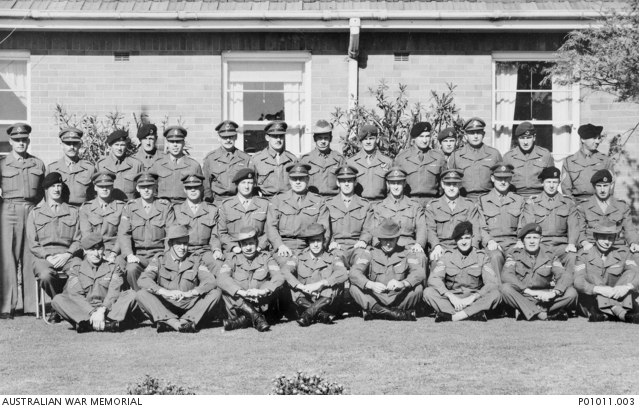
- July 31, 1962
AATTV Arrives in Vietnam
On arrival, the unit joined a large group of US advisors and were dispersed across South Vietnam in small groups. Three groups were dispatched to South Vietnam’s northern provinces, training members of the Army of the Republic of Vietnam (ARVN) at the National Training Centre at Dong Da and South Vietnamese Regional Forces (RF) at Hiep Khanh, while a fourth was based at the Ranger Training Centre at Duc My near Nha Trang in the south; a headquarters was established in Saigon. The groups began training the Vietnamese in barracks, providing instruction in “jungle warfare techniques and technical areas such as signals and engineering”. The jungle-warfare methods practiced by the AATTV emphasised patrolling and contact drills which taught soldiers to react automatically in battle with the aim of providing them with an advantage over an enemy which was reliant on command. Initially, the team was prevented from actively taking part in combat operations, and while this restriction was later lifted, until this occurred, the advisors deployed on operations as observers only.

- June 1, 1963
AATTV Combat Operations
Over time the role and of the AATTV changed, and in addition to training, individuals would often command units, advise South Vietnamese personnel and officials, serve as staff on headquarters, and determine policy. On 1 June 1963, Sergeant William Francis Hacking became the AATTV’s first casualty when he was accidentally killed while on duty in Vietnam. In late 1963 members of the team were redeployed into combat advisory roles, with two officers and eight NCOs working with Special Forces teams involved in counter-insurgency operations by February 1964. In mid-1964, the restriction on the AATTV advisors taking part in combat operations was lifted. The first advisor officially killed in action was Warrant Officer Class Two Kevin Conway at the Battle of Nam Dong on 6 July 1964. With the war escalating the AATTV increased, first to 60 in June and then to approximately 100 personnel – 15 officers and 85 warrant officers – by December. Soon its area of operations stretched from the far south to the Demilitarized Zone (DMZ) forming the border between North Vietnam and South Vietnam in the north.

- April 23, 1965
PM Menzies - Troops to Vietnam
The Australian Prime Minister Robert Menzies announces the dispatch of Australian forces to fight in Vietnam. On 29 April 1965, he announced an infantry battalion would travel to South Vietnam, with an armoured personnel carrier (APC) troop, a signals troop and a logistic support company.
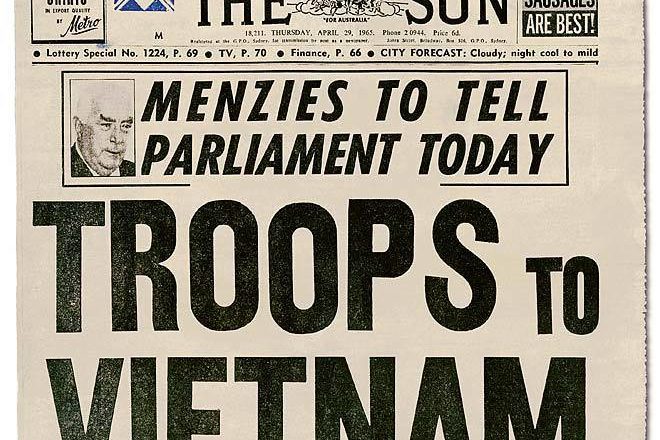
- May 24, 1965
1RAR's Advance Party Leaves for Vietnam
An advance party from 1st Battalion, Royal Australian Regiment (1RAR), departs from Richmond RAAF Base, NSW, for South Vietnam, for service with the US 173rd Airborne Division. The troops carry their weapons up the front steps of a Qantas Boeing 707 at Richmond RAAF Base, NSW, during the loading of men and equipment bound for Vietnam.

- June 6, 1965
6RAR Raised in Brisbane
6th Battalion Royal Australian Regiment which included D Company who fought in the Battle of Long Tan, was raised on this day, 6 June 1965 at Alamein Barracks, Enoggera in Queensland. A cadre of officers and NCOs and two rifle companies were transferred from 2 RAR to form the nucleus of the new battalion.
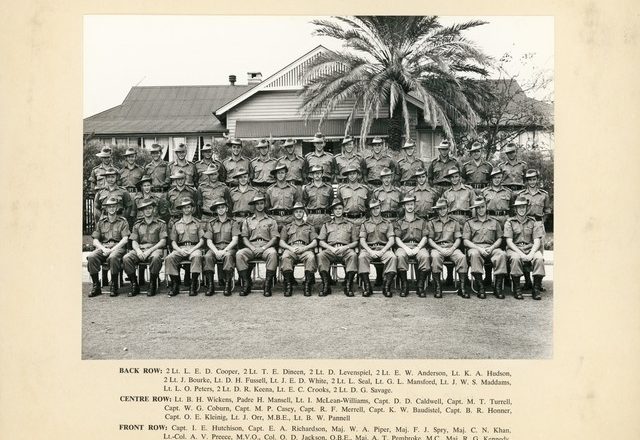
- June 8, 1965
1RAR Arrives in Vietnam
HMAS Sydney arrives at Vung Tau, South Vietnam, carrying the bulk of the Australian force. Troops of 1RAR relax on a Vietnamese Landing Craft at Vung Tau, South Vietnam, waiting for the half hour trip to shore from HMAS Sydney.
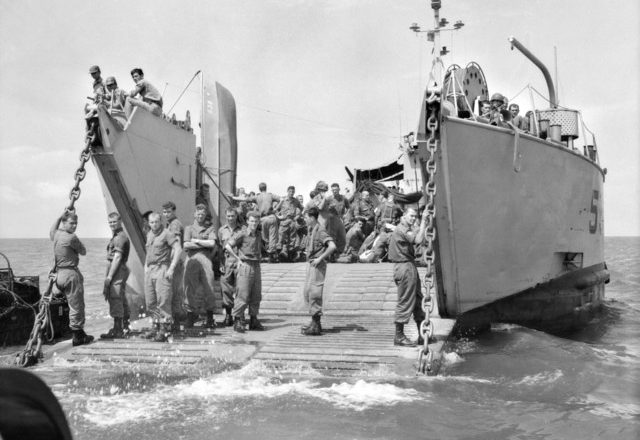
- July 1, 1965
1st Intake National Servicemen
The first national service intakes begin recruit training. After twelve weeks initial training at 1 Recruit Training Battalion at Kapooka, NSW; 3 TB at Singleton, N.S.W.; or 2 R.T.B. at Puckapunyal, Victoria; National Servicemen were assigned to the many different Corps. Most National Servicemen were allotted to the Infantry, enabling the Army to increase the Royal Australian Regiment to nine Battalions. Photo: Enoggera, Queensland 1966 Members of 8 platoon, C Company, 6th Battalion, Royal Australian Regiment, in the battalion lines at Enoggera, Queensland. From left: 2781803 Private Rodney Cox of Ganmain, NSW; 2781794 Private Gordon Stafford of Gunnedah, NSW; 2781823 Private Neil (Pop) Baker of Newcastle, NSW; 2781790 Private Mark (Scrub) Minell of Moree, NSW; 2781809 Private Graham Irvine of Coolamon, NSW. All five men were called up in the first intake of national service in July 1965.
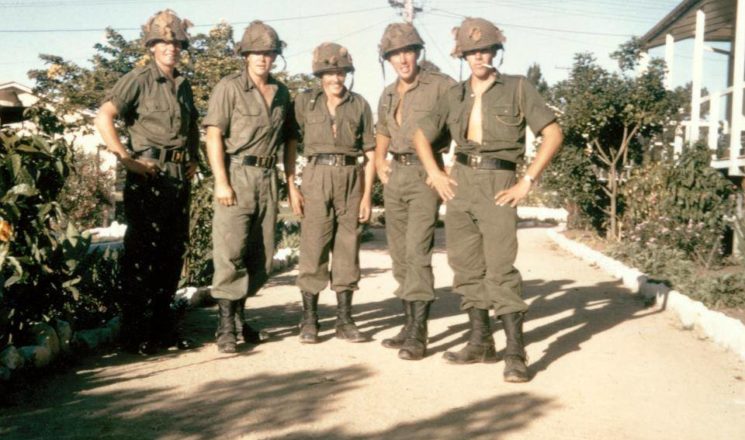
- August 17, 1965
Government - More Troops to Vietnam
The Australian Government approves an increase of Australian forces to fight in Vietnam. The force would increase to a battalion group, supported by artillery, additional APC’s, engineers, army helicopters, light aircraft and more logistic support.

- September 1, 1965
1st Intake NASHO's March Out
1 Intake Battalion (National Servicemen) march out parade in September 1965 Puckapunyal, Victoria which comprised five Companies of soldiers. The VIP (bottom Right) is the Hon. Dr. Forbes, Minister of the Army is the reviewing officer.
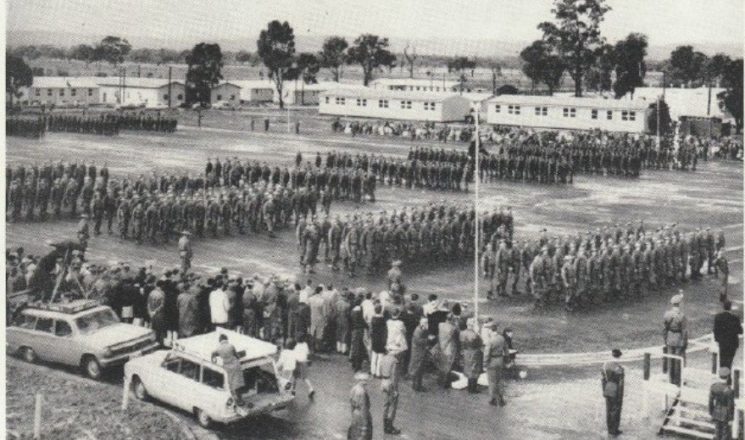
- September 15, 1965
6RAR Brought up to Full Strength
6RAR was brought up to full strength when a large draft of soldiers from the first National Service intake marched-in, in September 1965. A Morgan Gallup Poll finds 56% of those polled were in favour of continuing the war in Vietnam.
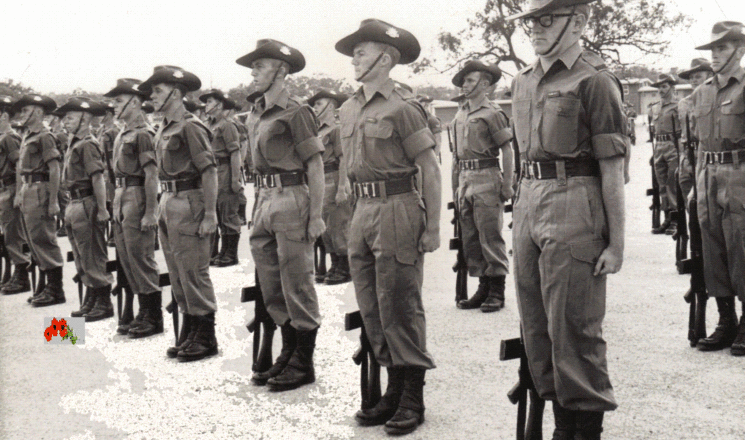
- January 26, 1966
Harold Holt Succeeds Menzies as Prime Minister
Having announced his retirement on January 20 1966, Sir Robert Menzies [on right] officially departed the Prime Ministership of Australia on this day in 1966. The first ministry of new Prime Minister Harold Holt [on left], was sworn in at the same time.
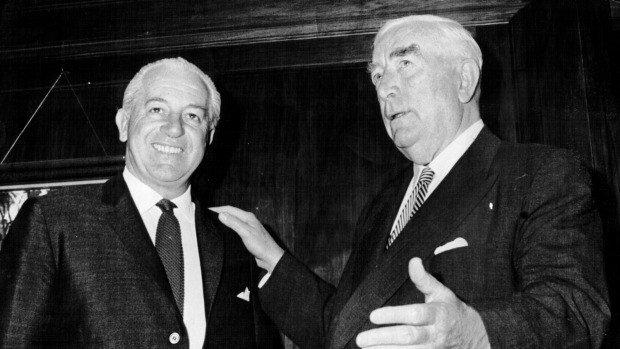
- March 6, 1966
PM Holt - More Troops to Vietnam
Australian Prime Minister Harold Holt announces the Australian commitment in South Vietnam will be Increased to a 4350-man task force, and will include conscripts. The 1st Australian Task Force (1ATF) will include two infantry battalions, a Special Air Service squadron, artillery, combat and support logistic units and eight RAAF Iroquois helicopters (9 SQN). The Task Force will be supported by 1 Australian Logistic Support Group (1 ALSG) to be established at Vung Tau. For the first time, national servicemen will be sent to South Vietnam. Photo: Harold Holt [left] and U.S. President Lyndon Johnson [right].
![Harold Holt [left] and U.S. President Lyndon Johnson [right]](https://battleoflongtan.com/wp-content/uploads/2023/12/Harold-Holt-Lyndon-Johnson-745x440.jpg)
- March 1, 1966
1ATF Arrives in Vietnam
5RAR arrived in Vung Tau by air and sea in March and April 1966. At that time the Battalion had no training with close support of Artillery, or in large scale assaults in helicopters. But the American Army, through the 68th Army Aviation Company, supplied the Battalion with the appropriate training during its short stay in Vung Tau. 5RAR formed half of the 1st Australian Task Force (1ATF) along with with 6RAR, SAS, RAAF, Artillery, APC’s, support and logistics. 1ATF replaced 1RAR in Vietnam and was stationed at Nui Dat in Phuoc Tuy province. Photo: 5RAR Arriving at Saigon, 28 April 1966

- May 24, 1966
5RAR Begins Move to Nui Dat
5 RAR deploys by helicopter from 1ATF concentration area at Vung Tau to secure the 1st Australian Task Force area at Nui Dat. Private Errol Noack becomes the first national serviceman and member of 1ATF to die from enemy action. Private Noack was conscripted into the army for service in Vietnam. He was killed by enemy fire during Operation Hardihood on 24 May 1966 after only ten days service in Vietnam. Photo: The funeral of Private Errol Noack in Adelaide in 1965.
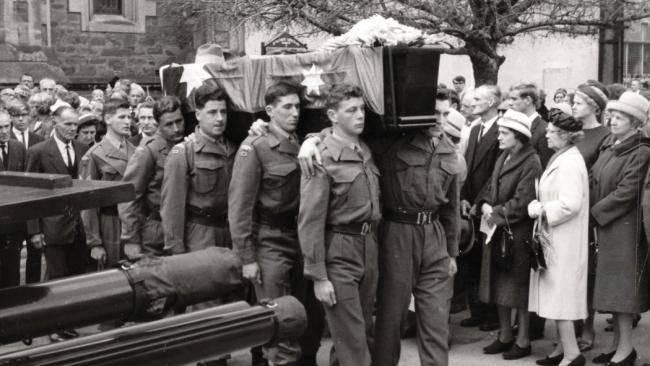
- June 6, 1966
9 Squadron RAAF Arrive Vietnam
On 6 June 1966, eight Iroquois helicopters from 9 Squadron, Royal Australian Air Force (RAAF), landed at the Vung Tau airbase, Vietnam. The Bell UH-1B Iroquois or “Huey” is almost synonymous with the Vietnam War and for the next five and a half years 9 Squadron’s Hueys supported the 1st Australian Task Force (1ATF). Photo: An RAAF UH-1B ‘Huey’ Iroquois helicopter, A2-1019, lined up with three other Iroquois helicopters at the 9 Squadron base at Vung Tau.
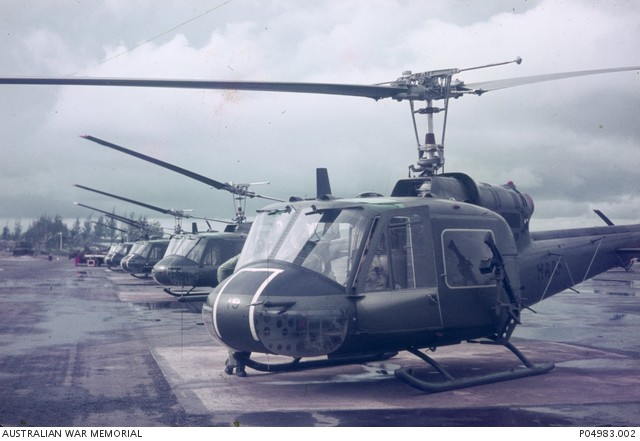
- June 6, 1966
6RAR Arrive in Vietnam
6RAR arrive at Vung Tau, Vietnam via the ‘Vung Tau Ferry’ (HMAS Sydney). They spend the next 5 days acclimatising in the sand hills of the Australian Logistics base at Vung Tau culminating in a battalion sized exercise on the last day.
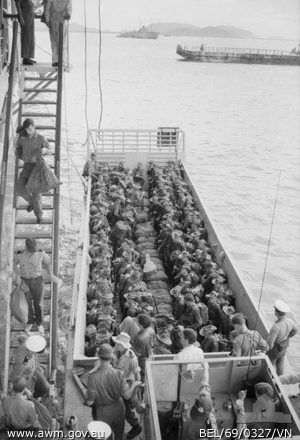
- June 14, 1966
6RAR Rushed to Nui Dat from Vung Tau
Due to increasing intelligence that the enemy might be moving into the Nui Dat area – location for the Australian task force (ATF) base – 6RAR are quickly moved by Chinook choppers from Vung Tau to Nui Dat ahead of schedule. The afternoon at Nui Dat was spent digging shell scrapes and clearing the immediate area. That night D Coy maintained 100% stand-to. It rained all night. Photo: D Company, 6RAR boarding a Chinook.
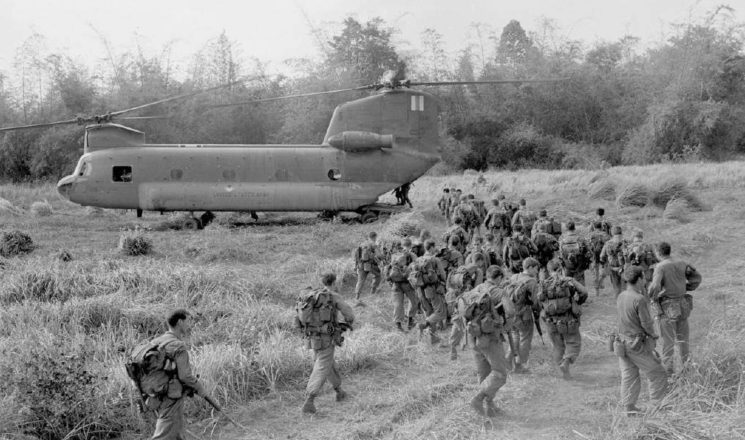
- June 21, 1966
Operation Enogerra
21 June to 5 July 1966, 6RAR’s first operation, Enoggera. D Coy, 6RAR’s job was to complete the destruction of a village. They were to destroy or remove any caches of food and other supplies and then destroy the tunnels and hides which honeycombed the area.
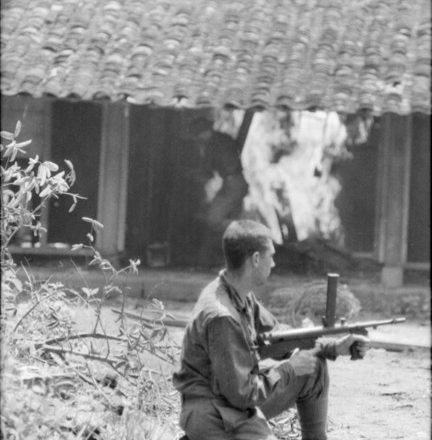
- June 24, 1966
Private Paul Large bitten by Scorpian
During a break in a patrol, Private Paul Large from 12 Platoon, D Coy, 6RAR had been bitten by a scorpion – not the small translucent brown ones but one of the bigger, highly venomous solid black ones. In minutes Paul was in a bad way. He was sweating profusely and his eyes were losing focus. The medic gave him some pills but within 15 minutes his temperature was well up and so Platoon commander 2Lt Sabben determined he had to be sent out. Sabben radioed that he had a medical casualty and requested a Dustoff flight (medivac chopper). It took another 10-15 minutes to clear it in as there was artillery being fired in the area. The Dustoff landed in a swirl of dust and leaves in a nearby clearing and Paul was on his way to hospital. As he was being carried to the chopper Large said, ‘Hurrah for the Flying Doctor!’ Private Paul Large was the last Australian killed in the Battle of Long Tan.
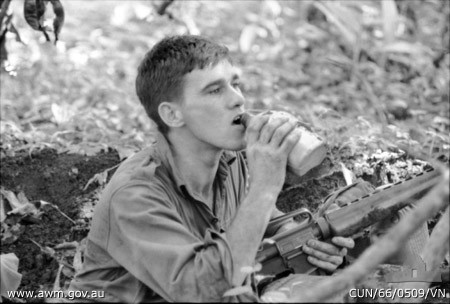
- July 24, 1966
Operation Hobart
6RAR’s next operation was called Hobart. The mission was to search and destroy the enemy in an area to the north-east and east of Long Tan and to search Long Tan itself for installations and caches. The Battalion returned to base on 29th July, 1966. After 3 days of searching nothing of significance was found. This operation, previous and future ones began to build an attitude of cry wolf among the diggers about any so called ‘intelligence’ reports. Photo: Xa Long Tan, Vietnam. July 1966. Soldiers of the 6th Battalion, The Royal Australian Regiment (6RAR) sit on the tops of the armoured personnel carriers (APCs), of A Squadron 3rd Cavalry Regiment, which are lined up along a road at the base camp during Operation Hobart. This operation was in two parts from 24 to 29 July when members of 6RAR were sent in to search in and around Long Tan. Large quantities of rice and cooking oil were found and destroyed, and some tunnels and caches destroyed. Two men were killed and seventeen wounded during this operation.
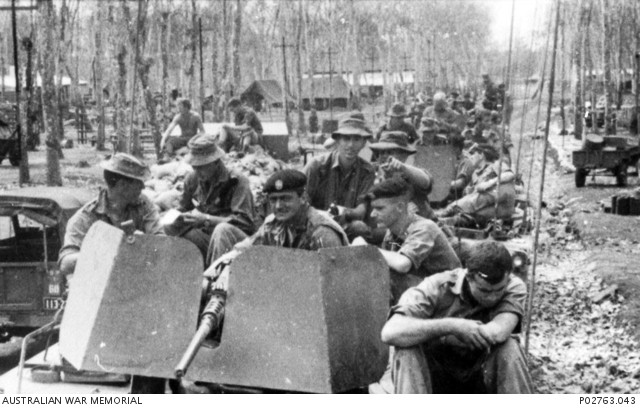
- July 29, 1966
Intel Reports Large VC Force Nearby
First reports come in from Australian adviser Capt Mike Wells that a VC battalion was seen in dense jungle within Line Alpha (a line encircling the ATF base out to 5km – all civilian populations were removed within this radius of the Australian base. Anyone in it could be more easily identified as enemy). Australian Capt. Mike Wells and his staff were attached to USA and South Vietnamese command to stay on top of allied strategy and operations and provide assessments and up to date information to the Australian Task Force.
In the afternoon two heavily armed Chinook choppers were ordered out to strafe the enemy position. So intense was the ground fire on the choppers that they reported they were receiving more than they were giving. An immediate airstrike was called on the position. Further reports came in indicating that 3,000 VC had arrived in Phuoc Tuy to attack allied forces. Jackson despatches Cap Robert Keep (ATF Intelligence officer) to HQ II FFV in Saigon with intelligence indicating a large enemy force was near Nui Dat. Keep relayed Jackson’s request for reinforcements. The American’s almost laughed them out of court based upon the resources they already had and comparing the information with what they already had.
547 Signal Troop (Australia’s top secret radio tracking unit) at Nui Dat begin tracking transmissions from the radio of the enemy North Vietnamese Army (NVA) 275 Regiment. Due to the scarcity of radios amongst the enemy, they would only be found at the regimental level and it was logical for intelligence to assume that along with this enemy radio was with the entire 275 Regiment (2,500+ soldiers). 547 Troop keep tracking the enemy radio through to 14 August, locating its last position at the Nui Dat 2 feature on the edge of the Long Tan rubber plantation. Ironically, this is where the first major attack on 11 Platoon, D Coy comes from on 18 Aug.
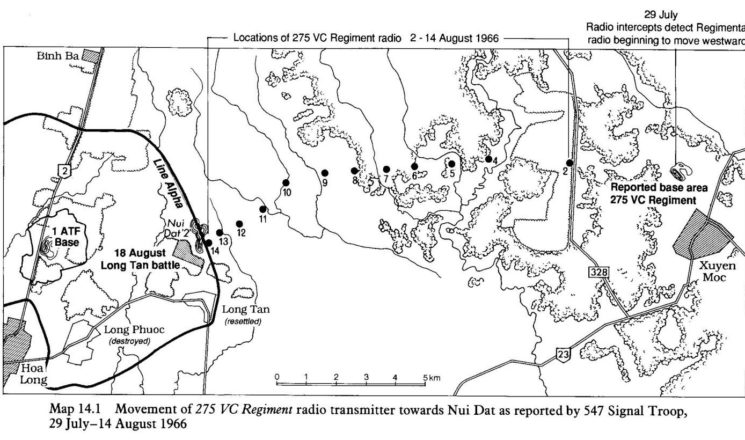
- July 30, 1966
3 Day Patrol by D Coy 6RAR
D Coy, 6RAR ordered out for a 3 day patrol to the north east extremity of Line Alpha near the Long Tan rubber plantation. They were to determine the extent of any enemy activity and locate and destroy any enemy camps.
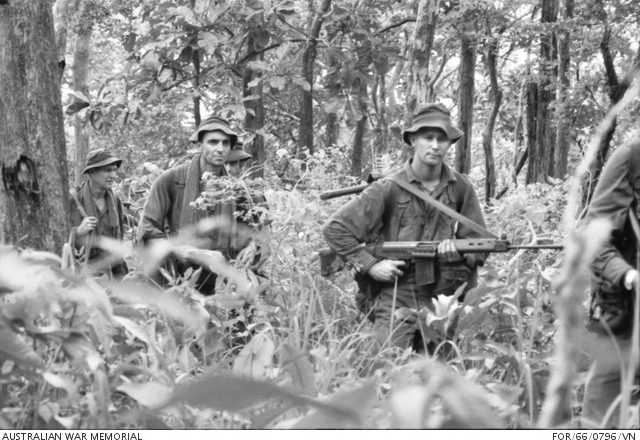
- August 9, 1966
Intel Officer Keep Departs Nui Dat
Capt Robert Keep sent to 2 Field Ambulance hospital at Vung Tau. Capt. Keep has been the most vocal proponent of an imminent large scale enemy attack on the Australia task force base at Nui Dat. Photo: Captain Robert Keep, General Staff Officer Grade 3 (Intelligence) on task force headquarters, arriving at 6th Battalion, the Royal Australian Regiment (6RAR) headquarters with the latest intelligence during Operation Hobart. He has just disembarked from a helicopter and is running through water on the edge of a paddy field.
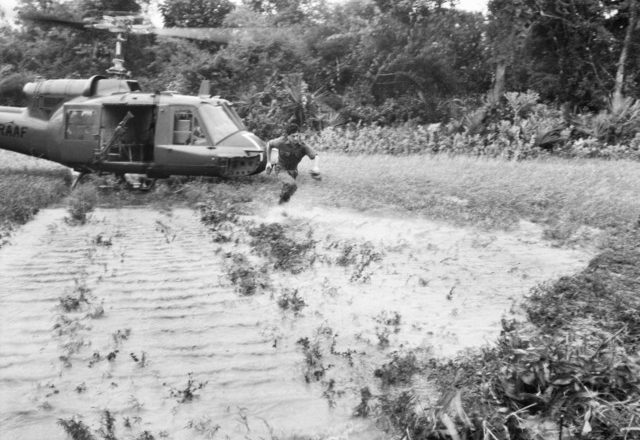
- August 15, 1966
D Coy 6RAR Return from Patrol
D Coy, 6RAR return from their 3 day patrol. Ironically their patrol took them to the north east around the Nui Dat 2 feature where the last reported enemy radio signals were picked up and then back via the Long Tan rubber plantation and the rubber tappers hut, but with no contact with the enemy. Capt Keep transferred to the RAAF hospital at Butterworth, Malaysia.

- August 16, 1966
Another Intel Officer Departs Nui Dat
Chief Intelligence officer Major John Rowe is evacuated to 2 Field Ambulance hospital at Vung Tau with Hepatitis. As fate would have it, 1ATF HQ had now lost both its intelligence officers.
Pte Paul Large from 12 Platoon fronts Major Harry Smith for punching a Lance Corporal. Large had been before Harry the Officer Commanding (OC) of D Coy three times previously. Harry was going to give him 21 days field punishment and 21 days loss of pay so Large asked for a court martial as he said he had good evidence and 4 witnesses to support his version of events. Large said he would have won the court martial as his witnesses would have said he only defended himself. Harry dismissed the charges. The real story was the Lance Corporal called Large a gutless little bastard so Large got stuck into him. His mates were prepared to lie to help him out! Private Paul Large was the last Australian killed in the Battle of Long Tan.
A Coy, 6RAR followed the patrol route of D Coy and they were based just north of the Long Tan rubber plantation, patrolling south over Nui Dat 2. A Coy discovered signs of enemy. Late in the afternoon they had several small contacts with enemy dressed in greens (Viet Cong guerrillas wore black and only regular North Vietnamese Soldiers (NVA) wore green). During one of these engagements an enemy officer was killed who appeared to be carrying details associated with the firing of the mortars. A Coy, 6RAR harbour for the night. In the early hours on the morning of 17 Aug they were startled by the sounds of significant and sustained mortar and artillery fire on the Australian base at Nui Dat some 5 km’s away. Photo: Gough Whitlam [left] with Lieutenant White [middle] and Major Rowe [right] in Hoa Long village, Vietnam, August 1966
![Gough Whitlam [left] with Lieutenant White [middle] and Major Rowe [right]](https://battleoflongtan.com/wp-content/uploads/2023/12/c99bc545b90ac2a8092f8967fd6b6312.jpg)
- August 17, 1966
1ATF Base at Nui Dat is Mortared
2.43am – The enemy bombard the Nui Dat base for 22 minutes resulting in 67 mortar craters. 24 Australians are wounded – one seriously who loses a leg. 7 vehicles are damaged and 21 tents damaged. The enemy artillery mainly and accurately targeted the Australian artillery, engineer lines and the FSCC command post.
2.50am – Australian counter-bombardment artillery and mortar fire commences.
4.10am – Australian artillery fire ceases.
4.50am – Townsend orders B Coy, 6RAR to patrol out and locate the enemy firing positions.
6.31am – B Coy with 80 men depart Nui Dat.
8.00am – B Coy locate first enemy mortar base plate position. They fan out and eventually locate sites for 5 x 82mm mortars and weapons pits for 35 men. They also locate tracks from the enemy party and follow it.
10.30am – The main track that B Coy are following fades away.
Midday – 6RAR now had three separate elements searching for the enemy in the general area of the base plate positions and to the north east of Nui Dat. A Coy was 500 metres north of Nui Dat, 9 Platoon C Coy was to the south of the known base plate positions and B Coy was between the two approximately 2km’s south west of A Coy and 1 km north east of 9 platoon. It was difficult to imagine that any significant numbers of enemy in the area could remain undetected. A Coy reported heavy enemy jamming of his radio transmissions.
5.30pm – A porter party with food rations arrives at B Coy. B Coy stay out overnight to continue the search.

- August 18, 1966
The Battle of Long Tan
7.05am – B Coy, 6RAR recommences the search but 48 men out of their compliment of approximately 100, return to Nui Dat for their scheduled R&R (Rest & Relaxtion).
8.00am – D Coy HQ, 6RAR radio signaller Graham Smith advises Harry that he received a message for him to report to Townsend to receive orders for a company patrol. Harry issues an informal warning order to D Coy to prepare for a patrol.
8.30am – D Coy begin to draw rations and ammunition, test fire their weapons and pack their equipment.
9.30am – Harry Smith holds an ‘O’ (orders) Group with his platoon commanders; 2Lt Dave Sabben (12 Platoon), 2Lt Gordon Sharp (11 Platoon), 2Lt Geoff Kendall (10 Platoon), NZ Artillery Observer Capt. Morrie Stanley, D Coy CSM (Company Sergeant Major Kirby) and Harry’s signallers to let them know about the patrol. Their orders are to locate the enemy mortar positions, locate and engage the enemy and relieve B Coy. Harry could feel the disappointment amongst his men at missing the concert. This concert scheduled for later that day was the first concert for the ATF in Vietnam and it featured the gorgeous 17 year older singer Little Pattie and Col Joye and the Joye Boys. Everyone had been looking forward to this rare treat and break from the monotony and boredom of life at Nui Dat. Some also felt that Harry’s strained relationship with his boss Lt. Col. Colin Townsend (Commanding Officer of 6RAR) might have contributed to D Coy drawing the short straw, once again.
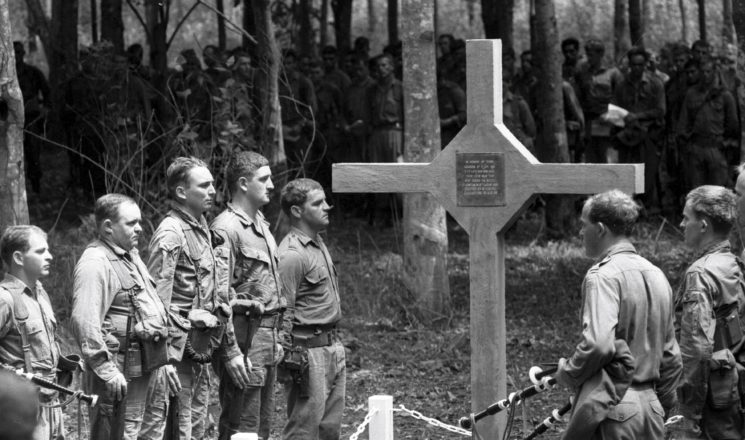
Click the button below to view a full timeline of the Battle of Long Tan.



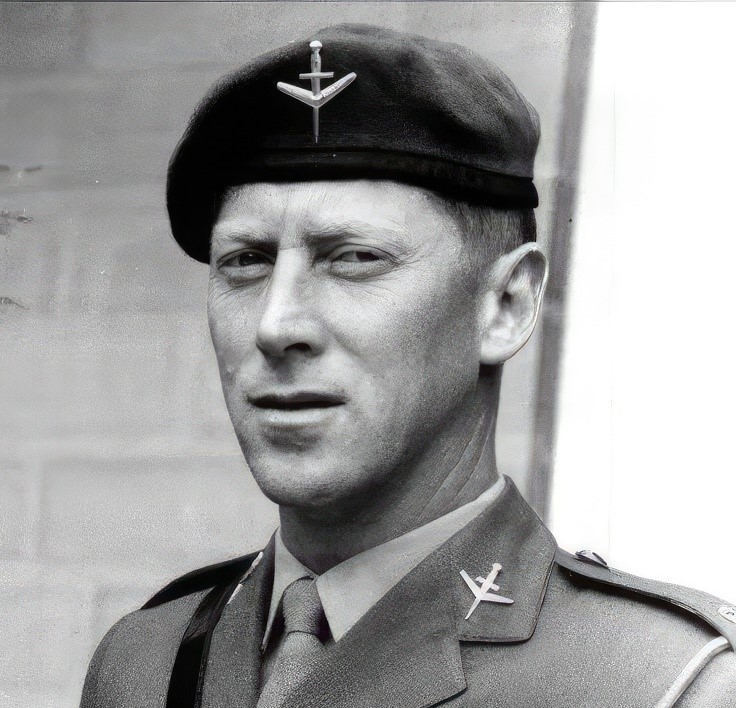

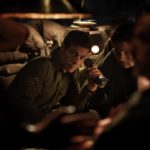
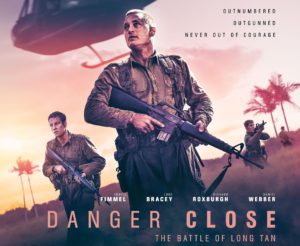
Facebook Comments